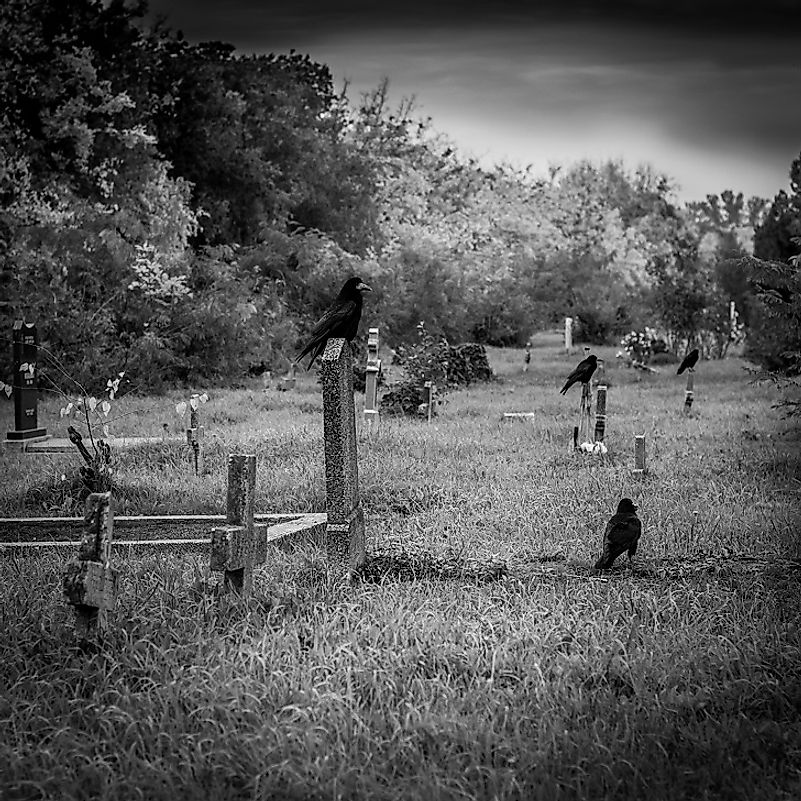Did You Know Crows Hold Funerals For One Another?

5. What Does A Crow Funeral Look Like?
The sight of a dead crow surrounded by a large crowd of watchful fellow members of their crow society is not an uncommon sight. These congregations of crows appear quite similar to those seen at a human funeral ritual. Besides crows on the ground, hundreds of these birds also appear to fly in from all directions, gathering on electrical utility poles, the branches of trees, the rooftops of homes, and anywhere else they may find a place for themselves to mourn for their dead society members. They are also heard voicing out their sadness with unified, continuous, cawing noises that can be hear throughout the neighboring areas. Quite aptly, this congregation of crows is called a “murder”, as if applying their visitation as an expression of shock for their murdered friends.
4. Possible Explanations for the Behavior
For years, scientists and the common man alike have wondered if the crows are gathering due to feelings of grief for their lost comrades, or just out of pure curiosity to comprehend the reason why their fellow beings are dead. Both of these reasons might be true, or either or neither of them might be true. Several scientific experiments have also been conducted to understand this strange behavior seen among the crows. Studies conducted by John Marzluff of the University of Washington in Seattle, USA, has shown that the hippocampus of the crows, a part of the brain associated with memory and learning, becomes active when a crow sights a person holding a dead crow. Crows have also have been observed to “scold” persons holding dead birds. Some other experiments with crows have also revealed that crows are highly wary of people who they had seen earlier carrying dead crows, and even when such a person arrives empty handed at a later time, the crows continue to scold the person with their cawing noises. The scientists perceive that, whether or not the crows are mourning for their dead, the “funeral” congregations of crows might act as a way by which these birds try to assess the nature of the threats that killed the other crow, and estimate the best way they can avoid such threats in the future for themselves and their living companions.
3. Intelligence Among Corvids
The fact that Corvids, the family of birds including crows, rooks, ravens, and jays, are some of the most highly intelligent birds, or any kind of species, in the Animal Kingdom is not unknown to human researchers. An interesting study involving six wild New Caledonian crows has revealed that crows can perform tasks that require a lot of wit. For example, the birds were presented with water containers with floating food rewards on water that was below the reach of the birds. Surprisingly, proving the Aesop’s Fables true, the birds picked up pebbles that would sink as against floating objects, with the pebbles also being placed in front of the birds, and dropped them into the water containers so as to bring up the level of water so that they could catch hold of their floating food rewards. Crows have also been known to recognize humans by their faces, and distinguish between friends and foes as proven by numerous research experiments. The Corvids are the only known non-primate family of species that can build tools like hooks and prodding sticks to extract food particles from logs or branches. Many scientists claim that crows have a reasoning ability at par with that of a human seven-year-old, while some scientists believe that these birds might be as intelligent as even the mature apes, or maybe even smarter still.
2. Is This Seen Among Other Animals?
Though mourning for the dead is an integral part of human society, very few other animals have been known to exhibit elaborate funeral-like rituals for their dead. In most animals, personal loss is felt when a family member is lost, but a mass congregation for other, not closely related, dead members of society, like in the case of crows, is hardly seen. A few other species in nature, like the dolphins, also appear to mourn for their dead, however, and have been shown to aggregate around a dead member of their species, holding on to the carcasses for a considerable period of time before finally letting go. African elephants have also exhibited similar feelings, nudging and nuzzling their dead and touching and grooming the corpses, a moving sight for those who watch such displays of affection. Heartbreaking videos of sea lions mourning for their own dead babies have also been distributed to the masses.
1. Unanswered Questions
There is a need to further comprehend the behavior of these creatures to understand why and how they react to their dead to further enhance our own knowledge of the animal world. Since animals do not speak human languages, we might never be able to know what they are actually thinking. However, such intelligent creatures as crows, elephants, sea lions, and dolphins do appear to have some kind of attachment to their dead. If what we perceive about these animals is actually true, we can well imagine the pain caused to these creatures due to the loss of their members to human persecution (crows treated as agricultural pests), bycatch fishing (dolphins are killed as a result of bycatch), poaching (elephants for their tusks), and hunting (sea-lions are hunted for their meat).











